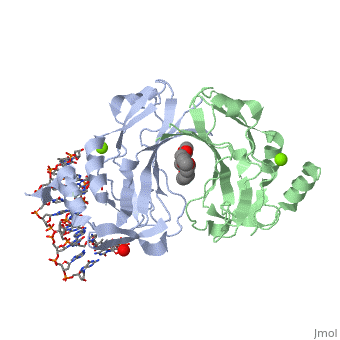2x6v
From Proteopedia
Crystal structure of human TBX5 in the DNA-bound and DNA-free form
Structural highlights
DiseaseTBX5_HUMAN Holt-Oram syndrome. The disease is caused by mutations affecting the gene represented in this entry. Defects in TBX5 are associated with susceptibility to dilated cardiomyopathy (DCM). A disorder characterized by ventricular and impaired systolic function, resulting in heart failure and arrhythmia. Patient are at risk of premature death.[1] [2] FunctionTBX5_HUMAN DNA-binding protein that regulates the transcription of several genes and is involved in heart development and limb pattern formation.[3] [4] [5] Evolutionary ConservationCheck, as determined by ConSurfDB. You may read the explanation of the method and the full data available from ConSurf. Publication Abstract from PubMedTBX5, a member of the T-box transcription factor family, plays an important role in heart and limb development. More than 60 single point or deletion mutations of human TBX5 are associated with Holt-Oram syndrome that manifests itself as heart and limb malformations in 1 out of 100,000 live births. The majority of these mutations are located in the TBX5 T-box domain. We solved the crystal structures of the human TBX5 T-box domain in its DNA-unbound form and in complex with a natural DNA target site allowing for the first time the comparison between unbound and DNA-bound forms. Our analysis identifies a 3(10)-helix at the C-terminus of the T-box domain as an inducible recognition element, critically required for the interaction with DNA, as it only forms upon DNA binding and is unstructured in the DNA-unbound form. Using circular dichroism, we characterized the thermal stability of six TBX5 mutants containing single point mutations in the T-box domain (M74V, G80R, W121G, G169R, T223M, and R237W) and compared them with wild-type protein. Mutants G80R and W121G show drastically reduced thermal stability, while the other mutants only show a marginal stability decrease. For all TBX5 mutants, binding affinities to specific and nonspecific DNA sequences were determined using isothermal titration calorimetry. All TBX5 mutants show reduced binding affinities to a specific DNA target site, although to various degrees. Interestingly, all tested TBX5 mutants differ in their ability to bind unspecific DNA, indicating that both sequence-specific and unspecific binding might contribute to the misregulation of target gene expression. Structural basis of TBX5-DNA recognition: the T-box domain in its DNA-bound and -unbound form.,Stirnimann CU, Ptchelkine D, Grimm C, Muller CW J Mol Biol. 2010 Jul 2;400(1):71-81. Epub 2010 May 5. PMID:20450920[6] From MEDLINE®/PubMed®, a database of the U.S. National Library of Medicine. See AlsoReferences
| ||||||||||||||||||||


